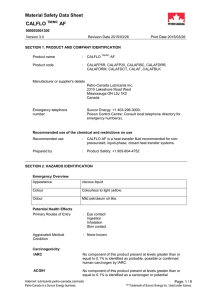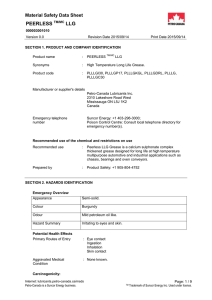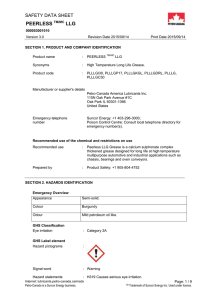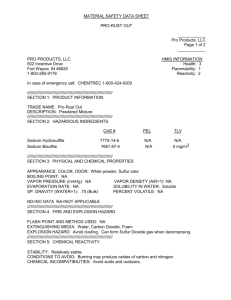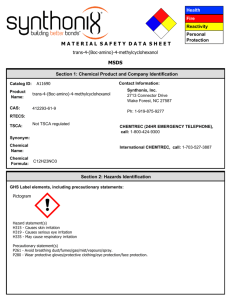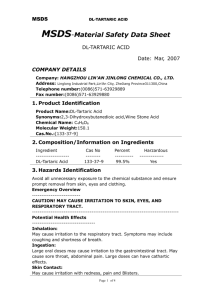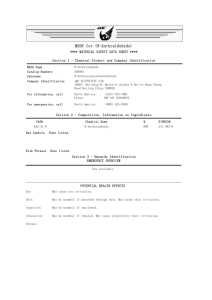GAS OIL - Petro
advertisement
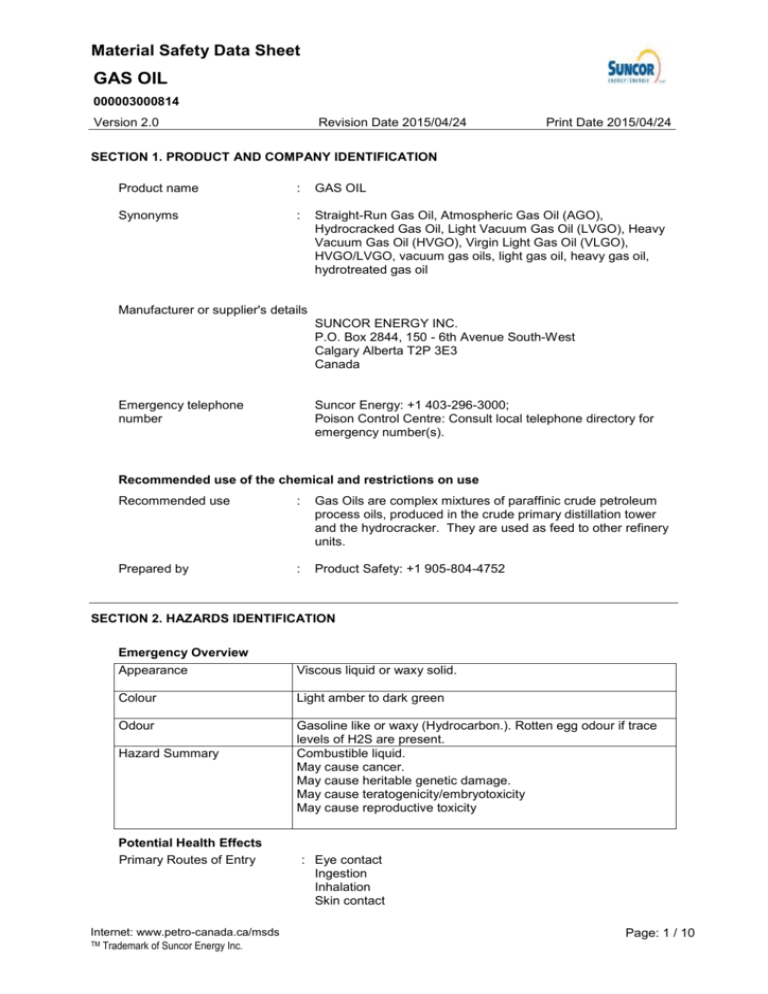
Material Safety Data Sheet GAS OIL 000003000814 Version 2.0 Revision Date 2015/04/24 Print Date 2015/04/24 SECTION 1. PRODUCT AND COMPANY IDENTIFICATION Product name : GAS OIL Synonyms : Straight-Run Gas Oil, Atmospheric Gas Oil (AGO), Hydrocracked Gas Oil, Light Vacuum Gas Oil (LVGO), Heavy Vacuum Gas Oil (HVGO), Virgin Light Gas Oil (VLGO), HVGO/LVGO, vacuum gas oils, light gas oil, heavy gas oil, hydrotreated gas oil Manufacturer or supplier's details SUNCOR ENERGY INC. P.O. Box 2844, 150 - 6th Avenue South-West Calgary Alberta T2P 3E3 Canada Emergency telephone number Suncor Energy: +1 403-296-3000; Poison Control Centre: Consult local telephone directory for emergency number(s). Recommended use of the chemical and restrictions on use Recommended use : Gas Oils are complex mixtures of paraffinic crude petroleum process oils, produced in the crude primary distillation tower and the hydrocracker. They are used as feed to other refinery units. Prepared by : Product Safety: +1 905-804-4752 SECTION 2. HAZARDS IDENTIFICATION Emergency Overview Appearance Viscous liquid or waxy solid. Colour Light amber to dark green Odour Gasoline like or waxy (Hydrocarbon.). Rotten egg odour if trace levels of H2S are present. Combustible liquid. May cause cancer. May cause heritable genetic damage. May cause teratogenicity/embryotoxicity May cause reproductive toxicity Hazard Summary Potential Health Effects Primary Routes of Entry Internet: www.petro-canada.ca/msds TM Trademark of Suncor Energy Inc. : Eye contact Ingestion Inhalation Skin contact Page: 1 / 10 Material Safety Data Sheet GAS OIL 000003000814 Version 2.0 Revision Date 2015/04/24 Print Date 2015/04/24 Inhalation : Inhalation may cause central nervous system effects. Inhalation of vapours may cause drowsiness, headache, dizziness, and disorientation. May cause irritation of the respiratory tract. Skin : May cause skin irritation. Contact with hot product will cause thermal burns. Eyes : May cause eye irritation. Possible burns as a result of eye contact with hot product. Ingestion : Ingestion may cause gastrointestinal irritation, nausea, vomiting and diarrhoea. Aspiration hazard if swallowed - can enter lungs and cause damage. Severe irritation of the mucous membranes causes vomiting, nausea and burns. Aggravated Medical Condition : Frequent or prolonged contact may irritate the skin and cause inflammation (dermatitis). Carcinogenicity: IARC Group 2A: Probably carcinogenic to humans ACGIH Gas oils, petroleum, light vacuum 64741-58-8 Gas oils, petroleum, heavy vacuum 64741-57-7 Gas oils, petroleum, straightrun 64741-43-1 No component of this product present at levels greater than or equal to 0.1% is identified as a carcinogen or potential carcinogen by ACGIH. SECTION 3. COMPOSITION/INFORMATION ON INGREDIENTS Substance / Mixture : Mixture Hazardous components Chemical Name CAS-No. Concentration (%) Gas oils (petroleum), light vacuum gas oils (petroleum), heavy vacuum distillates (petroleum), vacuum Gas oils (petroleum), straight-run Polycyclicaromatic hydrocarbons hydrogen sulphide 64741-58-8 64741-57-7 70592-78-8 64741-43-1 130498-29-2 7783-06-4 0 - 100 % 0 - 100 % 0 - 100 % 0 - 100 % < 10 % 0 - 0.005 % Internet: www.petro-canada.ca/msds TM Trademark of Suncor Energy Inc. Page: 2 / 10 Material Safety Data Sheet GAS OIL 000003000814 Version 2.0 Revision Date 2015/04/24 Print Date 2015/04/24 SECTION 4. FIRST AID MEASURES If inhaled : Move to fresh air. Artificial respiration and/or oxygen may be necessary. Seek medical advice. In case of skin contact : In case of contact, immediately flush skin with plenty of water for at least 15 minutes while removing contaminated clothing and shoes. Wash skin thoroughly with soap and water or use recognized skin cleanser. Wash clothing before reuse. Seek medical advice. In case of eye contact : Remove contact lenses. Rinse immediately with plenty of water, also under the eyelids, for at least 15 minutes. Obtain medical attention. If swallowed : Rinse mouth with water. DO NOT induce vomiting unless directed to do so by a physician or poison control center. Never give anything by mouth to an unconscious person. Seek medical advice. Most important symptoms and effects, both acute and delayed : First aider needs to protect himself. Notes to physician : No specific treatment. Treat symptomatically. For specialist advice physicians should contact the Poisons Information Service. SECTION 5. FIREFIGHTING MEASURES Suitable extinguishing media : Dry chemical Carbon dioxide (CO2) Water fog. Foam Unsuitable extinguishing media : Do NOT use water jet. Specific hazards during firefighting : Cool closed containers exposed to fire with water spray. Hazardous combustion products : Carbon oxides (CO, CO2), reactive hydrocarbons, smoke and irritating vapours as products of incomplete combustion. Further information : Prevent fire extinguishing water from contaminating surface water or the ground water system. Special protective equipment : Wear self-contained breathing apparatus and full protective Page: 3 / 10 Internet: www.petro-canada.ca/msds TM Trademark of Suncor Energy Inc. Material Safety Data Sheet GAS OIL 000003000814 Version 2.0 for firefighters Revision Date 2015/04/24 Print Date 2015/04/24 wear. Wear a positive-pressure supplied-air respirator with full facepiece. SECTION 6. ACCIDENTAL RELEASE MEASURES Personal precautions, protective equipment and emergency procedures : Use personal protective equipment. Ensure adequate ventilation. Evacuate personnel to safe areas. In case of inadequate ventilation wear respiratory protection. Avoid breathing vapour or mist. Environmental precautions : If the product contaminates rivers and lakes or drains inform respective authorities. Methods and materials for containment and cleaning up : Prevent further leakage or spillage if safe to do so. Clean up promptly by sweeping or vacuum. Remove all sources of ignition. Soak up with inert absorbent material. Non-sparking tools should be used. Ensure adequate ventilation. Contact the proper local authorities. SECTION 7. HANDLING AND STORAGE Advice on safe handling : For personal protection see section 8. Smoking, eating and drinking should be prohibited in the application area. In case of insufficient ventilation, wear suitable respiratory equipment. Avoid contact with skin, eyes and clothing. Do not ingest. Avoid exposure - obtain special instructions before use. Avoid contact during pregnancy/ while nursing. Use only with adequate ventilation. Do not enter places where used or stored until adequately ventilated. Use explosion-proof equipment. Hydrogen sulfide may accumulate in enclosed spaces. Open tank car hatches with caution. Do not use sparking tools. Ensure all equipment is electrically grounded before beginning transfer operations. Empty containers retain product residue and can be hazardous. Conditions for safe storage : Store in original container. Containers which are opened must be carefully resealed and kept upright to prevent leakage. Keep in a dry, cool and well-ventilated place. Keep in properly labelled containers. To maintain product quality, do not store in heat or direct sunlight. Ensure the storage containers are grounded/bonded. Page: 4 / 10 Internet: www.petro-canada.ca/msds TM Trademark of Suncor Energy Inc. Material Safety Data Sheet GAS OIL 000003000814 Version 2.0 Revision Date 2015/04/24 Print Date 2015/04/24 Hydrogen sulfide may accumulate in enclosed spaces. Open tank car hatches with caution. SECTION 8. EXPOSURE CONTROLS/PERSONAL PROTECTION Components with workplace control parameters Contains no substances with occupational exposure limit values. Engineering measures : Use only in well-ventilated areas. Use explosion-proof ventilation equipment. Adequate ventilation to ensure that Occupational Exposure Limits are not exceeded. Personal protective equipment Respiratory protection : Respirator selection must be based on known or anticipated exposure levels, the hazards of the product and the safe working limits of the selected respirator. Use a properly fitted, air-purifying or air-fed respirator complying with an approved standard if a risk assessment indicates this is necessary. Filter type Hand protection Material : A NIOSH-approved air-purifying respirator with an organic vapour cartridge or canister may be permissible under certain circumstances where airborne concentrations are expected to exceed exposure limits. Protection provided by airpurifying respirators is limited. Use a positive-pressure, airsupplied respirator if there is any potential for uncontrolled release, exposure levels are unknown, or any other circumstances where air-purifying respirators may not provide adequate protection. Wear a NIOSH-approved respirator/breathing apparatus in situations where there may be potential for airborne exposure. : polyvinyl alcohol (PVA), Viton(R). Consult your PPE provider for breakthrough times and the specific glove that is best for you based on your use patterns. It should be realized that eventually any material regardless of their imperviousness, will get permeated by chemicals. Therefore, protective gloves should be regularly checked for wear and tear. At the first signs of hardening and cracks, they should be changed. Remarks : Chemical-resistant, impervious gloves complying with an approved standard should be worn at all times when handling chemical products if a risk assessment indicates this is necessary. Eye protection : Wear face-shield and protective suit for abnormal processing problems. Skin and body protection : Choose body protection in relation to its type, to the concentration and amount of dangerous substances, and to the specific work-place. Internet: www.petro-canada.ca/msds TM Trademark of Suncor Energy Inc. Page: 5 / 10 Material Safety Data Sheet GAS OIL 000003000814 Version 2.0 Revision Date 2015/04/24 Print Date 2015/04/24 Protective measures : Wash contaminated clothing before re-use. Wear suitable protective equipment. Hygiene measures : Remove and wash contaminated clothing and gloves, including the inside, before re-use. Wash face, hands and any exposed skin thoroughly after handling. SECTION 9. PHYSICAL AND CHEMICAL PROPERTIES Appearance : Viscous liquid or waxy solid. Colour : Light amber to dark green Odour : Gasoline like or waxy (Hydrocarbon.). Rotten egg odour if trace levels of H2S are present. Odour Threshold : No data available pH : No data available Pour point : 0 - 50 °C (32 - 122 °F)(approx) Boiling point/boiling range : 205 - 600 °C (401 - 1112 °F) Flash point : > 80 °C (> 176 °F) Method: Pensky-Martens closed cup Fire Point : No data available Auto-Ignition Temperature : 355 °C (671 °F) Edmonton Hydrotreated Gas Oil Evaporation rate : No data available Flammability : Combustible. Upper explosion limit : No data available Lower explosion limit : No data available Vapour pressure : negligible Relative density : No data available Density : 0.88 - 0.94 kg/l (15 °C / 59 °F) Solubility(ies) Water solubility : insoluble Partition coefficient: noctanol/water : No data available Viscosity Viscosity, kinematic : Varies with crude sources. Explosive properties : Do not pressurise, cut, weld, braze, solder, drill, grind or expose containers to heat or sources of ignition. Containers may explode in heat of fire. Internet: www.petro-canada.ca/msds TM Trademark of Suncor Energy Inc. Page: 6 / 10 Material Safety Data Sheet GAS OIL 000003000814 Version 2.0 Revision Date 2015/04/24 Print Date 2015/04/24 SECTION 10. STABILITY AND REACTIVITY Possibility of hazardous reactions : Hazardous polymerisation does not occur. Stable under normal conditions. Conditions to avoid : Extremes of temperature and direct sunlight. Incompatible materials : Reactive with oxidising agents and acids. Hazardous decomposition products : May release COx, SOx, reactive hydrocarbons, smoke and irritating vapours when heated to decomposition. SECTION 11. TOXICOLOGICAL INFORMATION Information on likely routes of exposure : Eye contact Ingestion Inhalation Skin contact Acute toxicity Product: Acute oral toxicity : Remarks: No data available Acute inhalation toxicity : Remarks: No data available Acute dermal toxicity : Remarks: No data available Components: hydrogen sulphide: Acute inhalation toxicity : LC50 Rat: 444 ppm Exposure time: 4 h Test atmosphere: gas Skin corrosion/irritation Product: Remarks: No data available Serious eye damage/eye irritation Product: Remarks: No data available Components: hydrogen sulphide: Result: Eye irritation Respiratory or skin sensitisation Internet: www.petro-canada.ca/msds TM Trademark of Suncor Energy Inc. Page: 7 / 10 Material Safety Data Sheet GAS OIL 000003000814 Version 2.0 Revision Date 2015/04/24 Print Date 2015/04/24 No data available Germ cell mutagenicity No data available Carcinogenicity No data available Reproductive toxicity No data available STOT - single exposure No data available STOT - repeated exposure No data available Aspiration toxicity No data available SECTION 12. ECOLOGICAL INFORMATION Ecotoxicity Product: Toxicity to fish : Remarks: No data available Toxicity to daphnia and other aquatic invertebrates : Remarks: No data available Toxicity to algae : Remarks: No data available Toxicity to bacteria : Remarks: No data available Persistence and degradability Product: Biodegradability : Remarks: No data available Bioaccumulative potential No data available Mobility in soil No data available Other adverse effects No data available SECTION 13. DISPOSAL CONSIDERATIONS Disposal methods Internet: www.petro-canada.ca/msds TM Trademark of Suncor Energy Inc. Page: 8 / 10 Material Safety Data Sheet GAS OIL 000003000814 Version 2.0 Waste from residues Revision Date 2015/04/24 Print Date 2015/04/24 : The product should not be allowed to enter drains, water courses or the soil. Offer surplus and non-recyclable solutions to a licensed disposal company. Waste must be classified and labelled prior to recycling or disposal. Send to a licensed waste management company. Dispose of as hazardous waste in compliance with local and national regulations. Dispose of product residue in accordance with the instructions of the person responsible for waste disposal. SECTION 14. TRANSPORT INFORMATION International Regulation IATA-DGR Not regulated as a dangerous good IMDG-Code Not regulated as a dangerous good Transport in bulk according to Annex II of MARPOL 73/78 and the IBC Code Not applicable for product as supplied. 49 CFR Not regulated as a dangerous good TDG Not regulated as a dangerous good Special precautions for user Not applicable SECTION 15. REGULATORY INFORMATION WHMIS Classification : B3: Combustible Liquid D2A: Very Toxic Material Causing Other Toxic Effects This product has been classified according to the hazard criteria of the CPR and the MSDS contains all of the information required by the CPR. The components of this product are reported in the following inventories: DSL On the inventory, or in compliance with the inventory TSCA All chemical substances in this product are either listed on the TSCA Inventory or are in compliance with a TSCA Inventory exemption. EINECS On the inventory, or in compliance with the inventory SECTION 16. OTHER INFORMATION For Copy of (M)SDS Internet: www.petro-canada.ca/msds TM Trademark of Suncor Energy Inc. : Internet: www.petro-canada.ca/msds Canada-wide: telephone: 1-800-668-0220; fax: 1-800-837Page: 9 / 10 Material Safety Data Sheet GAS OIL 000003000814 Version 2.0 Revision Date 2015/04/24 Print Date 2015/04/24 1228 For Product Safety Information: 1 905-804-4752 Prepared by : Product Safety: +1 905-804-4752 The information provided in this Safety Data Sheet is correct to the best of our knowledge, information and belief at the date of its publication. The information given is designed only as a guidance for safe handling, use, processing, storage, transportation, disposal and release and is not to be considered a warranty or quality specification. The information relates only to the specific material designated and may not be valid for such material used in combination with any other materials or in any process, unless specified in the text. Internet: www.petro-canada.ca/msds TM Trademark of Suncor Energy Inc. Page: 10 / 10

